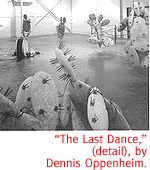

|

An Installation At The UA Museum Of Art Embraces The Desert's Deadly Dance.
By Margaret Regan
DENNIS OPPENHEIM pioneers an art form new to the Old Pueblo
in his gigantic installation piece The Last Dance. Call
it Brutal Art.
Taking up much of the first floor of the University of Arizona
Museum of Art, the aggressive 1992 work takes as its theme the
border along the U.S. and Mexico. A white sculpted human head
bangs--loudly--against a big bass drum; it goes 16 bangs in a
row, rests about 12 seconds, and then bangs all over again. Adding
to the aural jangle is a whole crop of old plastic radios, held
in a set of huge pink fiberglass hands bolted to the wall. The
radios are in old-fashioned turquoise and chrome, tinnily playing
out the rock and roll of local radio. But if the din is dangerous
to your ears--I had to cover mine--the dancing cacti pose their
own perils.
 Prickly pears are the partners in this dance, a minuet between
two cultures that alternately love and loathe the other. Made
out of green fiberglass and clusters of sharp nails, the four
pairs of cacti are twisted into humanoid shapes. Three of the
cactus couples are moving about the room on wires hung from the
ceiling, and if you don't watch where you're going you run the
risk of being impaled.
Prickly pears are the partners in this dance, a minuet between
two cultures that alternately love and loathe the other. Made
out of green fiberglass and clusters of sharp nails, the four
pairs of cacti are twisted into humanoid shapes. Three of the
cactus couples are moving about the room on wires hung from the
ceiling, and if you don't watch where you're going you run the
risk of being impaled.
One pair of dancers circles warily about each other, traveling
a regular orbit that will prevent them ever from meeting. Two
other sets touch each other with their arm-like pads, with mixed
results. One pair seems to have succeeded in sexual congress,
while in the other one partner is struggling to flee. The fourth
pair, immobile on the floor, look like they just may be in a combat
to the death. Their necks are bound to each other by a black cord,
and one seems ready to give up the fight.
 The border may be porous, but it's a powerful cultural idea and
a sometimes fatal physical barrier. Oppenheim's piece takes on
some of the lighter stereotypes about life on the other side.
A big row of letters on the floor slowly moves around a pivot,
sometimes spelling out the words "Sunny Dormitory,"
sometimes "Su Dor" (golden south, perhaps). It's like
a welcome sign, announcing Mexico as a gringo playland, filled
with cheap music and exotic cactus.
The border may be porous, but it's a powerful cultural idea and
a sometimes fatal physical barrier. Oppenheim's piece takes on
some of the lighter stereotypes about life on the other side.
A big row of letters on the floor slowly moves around a pivot,
sometimes spelling out the words "Sunny Dormitory,"
sometimes "Su Dor" (golden south, perhaps). It's like
a welcome sign, announcing Mexico as a gringo playland, filled
with cheap music and exotic cactus.
But the piece is much harsher, and more serious, than that. It's
hard to miss the implications of the spiny cacti doing their dangerous
minuet of misunderstanding and death. And in this blazing summer,
when Mexicans hoping to work in the United States have perished
by the score in the unforgiving desert, a head banging itself
painfully against a drum, over and over, needs no further explanation.
The Last Dance remains on view through Sunday,
September 20, at the University of Arizona Museum of Art. UA prof
Miguel Mendez will give a free talk, in Spanish, on folklore and
literature of the border, at 12:15 p.m., Wednesday, September
9. Museum hours are 9 a.m. to
5 p.m. Monday through Friday, noon to 4 p.m. Sundays. Free admission.
For more information call 621-7567.

|
 |





